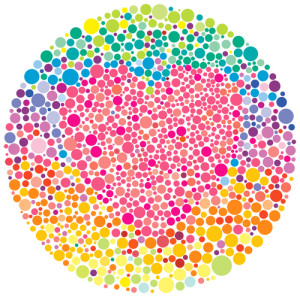SEEING IN COLOR
For many people being, able to walk along a crowded downtown street, look up at the streetlight, and be able to see if the light is red, yellow, or green, is a common occurrence that we rarely think twice about. There are many people, however, who have never experienced this. They are color blind or are color blind to some degree.
While color blindness is most common in men, affecting as many as 8% of men, it can also occur in women. They experience a much lower percent, with as little as .5% of women being color blind.
The reason that men are much more susceptible to suffering from color blindness is that gene responsible for color blindness is on the X chromosome. With males only having one X chromosome, if there is any deficiency they will begin to lose the ability to see colors. Women, have two X chromosomes. Because of this, women have the advantage that if one X chromosome is deficient, the other is able to overcome that gene allowing them to see in color.
The most common types of color blindness are inherited. Color blindness can range greatly in the degree of colors which are able to be seen. Some people can see darker colors easier than light, such as a dark red vs. a light red, with the light red being more difficult to distinguish.
There are three main categories that people who are color blind fall into.
- Red-Green Color Blindness. The most common type of color blindness. It is caused by the loss or limited function of red cone or green cone photo pigments. People with red-green color blindness struggle to distinguish red and green colors, seeing them as different colors or even black.
- Blue-Yellow Color Blindness. This color loss is rarer than red-green color blindness. The blue-cone photo pigments are either missing or have limited function. This form of color blindness affects the ability to distinguish yellow, and often shows yellow and red as pink. Blue can also appear as green and yellows as violet or light gray.
- Complete Color Blindness. People who suffer from complete color blindness see no colors at all. They may also have the clearness of their vision affected in people who suffer from complete color blindness.
There are many tests that your eye doctor can perform to determine if you are in fact color blind. If so, to determine what category of color blindness that you fall into. It is important to have children checked at a young age as many times they do not know that they are color blind. Children that are born with difficulty seeing colors do not know the difference of what life is like with all colors being portrayed as they should be. Because color blindness is hereditary, it is especially important if one parent is color blind to have regular checkups for the entire family.
There is currently no cure for color blindness, however people with red-green color blindness may be able to use a special set of lenses to help them see colors more accurately. These lenses are typically only to be used outdoors under bright light conditions.
About the author: John D. Bissell, owner of Bissell Eye Care and Tri-State Low Vision Services, offers comprehensive eye examinations for the entire family, ocular disease detection and treatment, eye glasses, sun glasses, active wear, contact lenses, and low vision examinations for those with significant vision loss. He has undergone specialized training for treatment of low vision by the International Academy of Low Vision Specialists utilizing customized telescopic eyeglasses, prisms and telescopic implants for patients who qualify. The practice accepts most types of vision and health insurance plans.

